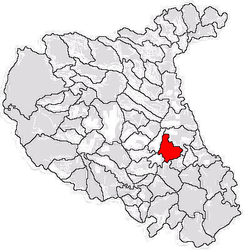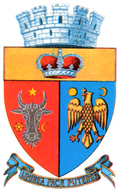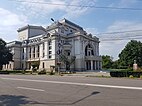Focșani
Focșani | |
|---|---|
Aerial view of Union Square Municipal Theatre Former administrative palace St. John the Baptist Church | |
|
Coat of arms | |
 Location in Vrancea County | |
| Coordinates: 45°42′0″N 27°10′47″E / 45.70000°N 27.17972°E | |
| Country | Romania |
| County | Vrancea |
| Government | |
| • Mayor (2020–2024) | Cristi-Valentin Misăilă[1] (PSD) |
| Area | 48.1 km2 (18.6 sq mi) |
| Elevation | 46 m (151 ft) |
| Population (2021-12-01)[2] | 66,648 |
| • Density | 1,400/km2 (3,600/sq mi) |
| Time zone | EET/EEST (UTC+2/+3) |
| Postal code | 620003–620177 |
| Vehicle reg. | VN |
| Website | www |
Focșani (Romanian:
Geography
Focșani lies at the foot of the Curvature Carpathians, at a point of convergence for tectonic geologic faults, which raises the risk of earthquakes in the vicinity. Though Vrancea County is one of the most popular wine-producing regions in Romania, Odobești being just to the northwest, in Romania, Focșani itself is not considered a wine-producing center. The wine sold as Weisse von Fokshan in Germany and some other European countries is generally a Fetească Albă de Odobești wine, and practically a second-rated wine which does not comply to the European Union rules of naming the regions of origin of wines.
The vicinity is rich in minerals such as iron, copper, coal, and petroleum.[3]
The city administers two villages, Mândrești-Moldova and Mândrești-Munteni.
Focșani lies within the strategically important Focșani Gate. In the 19th century, the Focșani–Nămoloasa–Galați line was built to defend this area more properly.[4]
Seismic hazard
The territory of Vrancea County corresponds to the most seismically active zone of Romania.
The earthquakes with the
.History

As a town on the Moldavian-Wallachian border, Focșani developed into an important trade center halfway between the Russian Empire and the Balkans. A congress between Imperial Russian and Ottoman diplomats took place near the city in 1772. Near the town, the Ottomans suffered a severe defeat at the hands of the allied forces of the Habsburg monarchy under Prince Frederick Josias of Saxe-Coburg-Saalfeld and Imperial Russia under Alexander Suvorov in 1789 (see Battle of Focșani).
In the 1850s (after the
On 30–31 December 1881, following the impact of
In 1917, during the
In 1944, during


Demographics
| Year | Pop. | ±% |
|---|---|---|
| 1859 | 13,164 | — |
| 1899 | 23,601 | +79.3% |
| 1912 | 25,066 | +6.2% |
| 1930 | 32,481 | +29.6% |
| 1948 | 27,960 | −13.9% |
| 1956 | 28,244 | +1.0% |
| 1966 | 35,094 | +24.3% |
| 1977 | 56,252 | +60.3% |
| 1992 | 101,335 | +80.1% |
| 2002 | 103,219 | +1.9% |
| 2011 | 79,315 | −23.2% |
| 2021 | 66,648 | −16.0% |
| Source: Census data | ||
As of 2011 census data, Focșani has a population of 73,868,[6] a decrease from the figure recorded at the 2002 census, making it the 27th largest city in Romania.
According to the census from 2002, there were 101,854 people living within the city of Focșani.[7] The ethnic makeup was as follows:
- Romanians: 98.68%
- Roma: 1.07%
- Hungarians: 0.05%
- Other: 0.2%
Coat of arms

Focșani's location on the
Natives
- Valentina Ardean-Elisei
- Camil Baltazar
- Constantin C. Giurescu
- Simona Gogîrlă
- Carl Grünberg
- Leon Kalustian
- Dinu Kivu
- Ion Mincu
- Cilibi Moise
- Alin Moldoveanu
- Ion Nestor
- Anghel Saligny
- Oscar Sager
- Solomon Schechter
- George Simion
- Gheorghe Tattarescu
International relations
Focșani is
References
- ^ "Results of the 2020 local elections". Central Electoral Bureau. Retrieved 9 June 2021.
- ^ "Populaţia rezidentă după grupa de vârstă, pe județe și municipii, orașe, comune, la 1 decembrie 2021" (XLS). National Institute of Statistics.
- ^ Chisholm, Hugh, ed. (1911). . Encyclopædia Britannica. Vol. 10 (11th ed.). Cambridge University Press. p. 587.
- ^ Mîndrescu, Mircea; Melcher, Gregory; Petersen, Phillip (2019). "The Focșani Gate – a key terrain for European security" (PDF). New Strategy Center, Centre for the Study of the New Generation Warfare. pp. 1–20.
- ISBN 0295954442.
- ^ "2011 Census" (in Romanian). INSSE at vranceamedia.ro. February 2, 2012. Archived from the original on March 4, 2016. Retrieved March 12, 2012.
- ^ "Ethno-demographic Structure of Romania". The Ethnocultural Diversity Resource Center. Retrieved January 2, 2011.
- ^ "Cooperare internațională". focsani.info (in Romanian). Focșani. Retrieved 2019-10-26.






